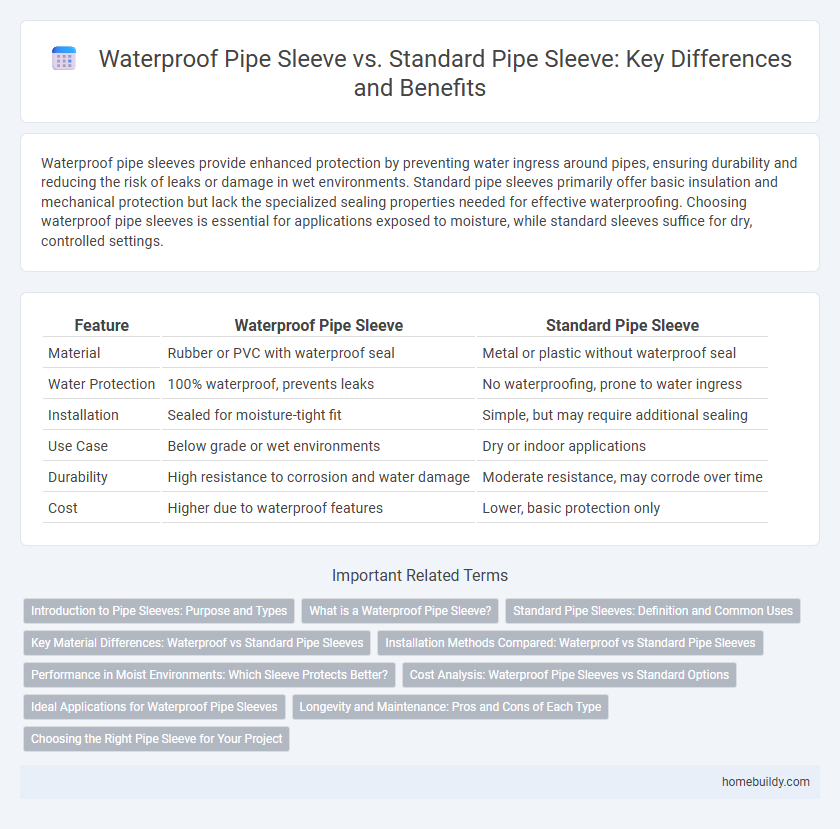Waterproof pipe sleeves provide enhanced protection by preventing water ingress around pipes, ensuring durability and reducing the risk of leaks or damage in wet environments. Standard pipe sleeves primarily offer basic insulation and mechanical protection but lack the specialized sealing properties needed for effective waterproofing. Choosing waterproof pipe sleeves is essential for applications exposed to moisture, while standard sleeves suffice for dry, controlled settings.
Table of Comparison
| Feature | Waterproof Pipe Sleeve | Standard Pipe Sleeve |
|---|---|---|
| Material | Rubber or PVC with waterproof seal | Metal or plastic without waterproof seal |
| Water Protection | 100% waterproof, prevents leaks | No waterproofing, prone to water ingress |
| Installation | Sealed for moisture-tight fit | Simple, but may require additional sealing |
| Use Case | Below grade or wet environments | Dry or indoor applications |
| Durability | High resistance to corrosion and water damage | Moderate resistance, may corrode over time |
| Cost | Higher due to waterproof features | Lower, basic protection only |
Introduction to Pipe Sleeves: Purpose and Types
Pipe sleeves provide protection and structural integrity where pipes penetrate walls or floors, preventing damage to both the pipe and surrounding materials. Waterproof pipe sleeves are specifically designed with sealing features to prevent moisture ingress, making them ideal for wet environments, while standard pipe sleeves offer basic protection without moisture resistance. Choosing the appropriate pipe sleeve depends on the installation conditions, such as exposure to water or the need for environmental sealing.
What is a Waterproof Pipe Sleeve?
A waterproof pipe sleeve is a specialized conduit designed to prevent water infiltration around pipes passing through walls or floors, incorporating robust sealing materials such as rubber gaskets or flexible membranes. Unlike standard pipe sleeves, which primarily provide a protective barrier for pipe installation, waterproof pipe sleeves ensure a watertight seal critical for environments prone to moisture exposure. These sleeves enhance structural integrity and prevent water damage, mold growth, and corrosion in plumbing and construction systems.
Standard Pipe Sleeves: Definition and Common Uses
Standard pipe sleeves are cylindrical protective barriers typically made from metal, plastic, or rubber used to encase pipes passing through walls, floors, or ceilings. These sleeves provide structural support to prevent pipe damage from physical impacts and allow for thermal expansion and contraction. Common applications include plumbing systems, electrical conduit protection, and HVAC installations where moisture resistance is not a primary concern.
Key Material Differences: Waterproof vs Standard Pipe Sleeves
Waterproof pipe sleeves are typically constructed using materials such as rubber, silicone, or specialized polymers designed to provide a watertight seal around pipes, preventing moisture infiltration. Standard pipe sleeves often use basic plastic or metal materials that lack inherent waterproofing properties, serving primarily as a protective barrier without moisture resistance. The key material difference lies in the waterproof sleeves' composition, which is engineered to resist water penetration, making them ideal for applications in wet or underground environments where pipe integrity against water damage is critical.
Installation Methods Compared: Waterproof vs Standard Pipe Sleeves
Waterproof pipe sleeves incorporate integrated sealing components such as gaskets or membranes that ensure a watertight seal during installation, preventing water ingress around pipes. In contrast, standard pipe sleeves typically require additional external sealing measures like caulking or sealants, increasing installation complexity and time. The installation of waterproof sleeves is more streamlined and reliable for moisture-sensitive applications, reducing potential leaks and maintenance needs.
Performance in Moist Environments: Which Sleeve Protects Better?
Waterproof pipe sleeves offer superior protection in moist environments by preventing water infiltration and corrosion around pipes, ensuring long-term durability and structural integrity. Standard pipe sleeves typically lack sealed barriers, making them susceptible to moisture exposure, which can lead to rust and damage over time. Choosing waterproof pipe sleeves significantly enhances performance by maintaining a dry, secure seal that withstands humidity, condensation, and water exposure more effectively than standard alternatives.
Cost Analysis: Waterproof Pipe Sleeves vs Standard Options
Waterproof pipe sleeves typically incur higher upfront costs than standard pipe sleeves due to specialized materials such as rubber gaskets and sealing compounds that prevent water intrusion. While standard pipe sleeves offer budget-friendly installation, they lack protective features against moisture, potentially leading to costly water damage repairs and maintenance over time. Investing in waterproof pipe sleeves can reduce long-term expenses by minimizing leak risks, waterproofing failures, and associated structural damages.
Ideal Applications for Waterproof Pipe Sleeves
Waterproof pipe sleeves are essential in environments prone to moisture exposure, such as underground installations, basements, and areas with high water tables, providing reliable protection against water ingress and corrosion. These sleeves are ideal for HVAC systems, plumbing penetrations, and electrical conduit passages where sealing against water is critical to maintaining system integrity and preventing damage. Standard pipe sleeves, while suitable for general use, lack the advanced sealing properties necessary for such demanding applications.
Longevity and Maintenance: Pros and Cons of Each Type
Waterproof pipe sleeves offer superior longevity by preventing moisture infiltration and corrosion, reducing maintenance frequency compared to standard pipe sleeves. Standard pipe sleeves are more prone to wear and water damage, requiring frequent inspections and repairs to ensure pipe integrity. Choosing waterproof sleeves can lower long-term maintenance costs and extend pipe service life, while standard sleeves may be more cost-effective upfront but demand higher upkeep.
Choosing the Right Pipe Sleeve for Your Project
Waterproof pipe sleeves provide superior protection against moisture infiltration, making them ideal for projects exposed to water or high humidity environments. Standard pipe sleeves offer basic protection and are suitable for applications where water exposure is minimal or controlled. Selecting the appropriate pipe sleeve depends on the specific environmental conditions and the level of waterproofing required to ensure durability and prevent damage.
Waterproof pipe sleeve vs Standard pipe sleeve Infographic

 homebuildy.com
homebuildy.com